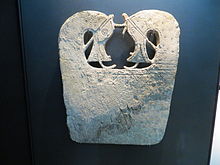Tablet made from whale bones


Chalkboards or plates made of whale bones (from English Whalebone plaque , Norwegian hvalbeinsplater or Glatteplater ; no German name) come from the Viking Age context in Scandinavia and Orkney .
distribution
Most of the plates (40) were found in western Norway . Some plates have been found in the UK (one on Sanday , Orkney ), Denmark and Birka , Sweden - one in a grave and three in the settlement. The Danish, Swedish and English specimens were likely imported from Norway, where whale bone processing was common.
The tablets were often discovered in richly decorated women's graves and were probably prestige items. The best-preserved 34.5 cm high Norwegian table is the table from Lilleberga , ( Namdalen ). It was found in a 9th or 10th century grave. The large tablet found in Birka is one centimeter higher, 24.5 cm wide and 1.8–2.3 cm thick. The always zoomorphic double motif in the upper third, which can also be combined with an eyelet for hanging, is formed by dragons, horses or birds. The " Scar Dragon Plaque " found in the boat grave of Scar is outstanding .
Materials and methods
Bones were used all over Europe for making devices. Whale bones were at least available from stranded whales . During the Viking Era, the bone plates were machined, smoothed with pumice stone, and polished with a variety of tools .
use
Since one of the plates was found together with a solid glass cylinder that was used for ironing , use as an ironing board is being discussed. Bail cylinders in a similar shape were in use until the 19th century. The use of glass cylinders to smooth textiles or to press creases is well documented in sources. The glass objects or their fragments were found in women's graves in the former Viking area. The assignment of the whale bone tablets to the ironing process is more problematic, as only one of the 40 known tablets was found together with a glass straightener. A more recent theory suggests that the plates were used for food prep at high festivals, as cutting and chopping marks were found on some.
Whalebone smoothing boards are said to have been used well into the 19th century.
See also
literature
- Eva Andersson: Tools for Textile Production from Birka and Hedeby. Excavations in the Black Earth 1990-1995 (= Birka Studies. 8). Birka Project for Riksantikvarieämbetet, Stockholm 2003, ISBN 91-7209-295-5 .
- Martin Biddle, Linden Elmhirst: Sewing equipment. In: Martin Biddle: Object and economy in medieval Winchester (= Artefacts from medieval Winchester. 2 = Winchester Studies. 7, 2, ZDB -ID 750501-2 ). The Clarendon Press, Oxford 1990, pp. 804-817.
- Arthur MacGregor: Bone, Antler, Ivory & Horn. The technology of skeletal materials since the Roman period. Croom Helm et al., London et al. 1985, ISBN 0-7099-3242-1 .
- Ailsa J. Mainman, Nicola SH Rogers: Craft Industry and Everyday Life. Finds from Anglo-Scandinavian York (= The Archeology of York. Vol. 17: The Small Finds. Fasc. 14). Council for British Archeology for the York Archaeological Trust, London 2000, ISBN 1-902771-11-7 .
- Mona Mortensen: "When they speed the shuttle". The role of textile production in Viking Age society, as reflected in a pit house from Western Norway. In: Lise Bender Jørgensen, Christina Rinaldo (Eds.): Textiles in European Archeology. Report from the 6th NESAT Symposium, 7-11th May 1996 in Borås (= GOTARC. Series A, Vol. 1). Goteborg University - Department of Archeology, Göteborg 1998, ISBN 91-85952-74-5 , pp. 187-195
- I. Panter: Amber working tools and techniques. In: Ailsa J. Mainman, Nicola SH Rogers: Craft Industry and Everyday Life. Finds from Anglo-Scandinavian York (= The Archeology of York. Vol. 17: The Small Finds. Fasc. 14). Council for British Archeology for the York Archaeological Trust, London 2000, ISBN 1-902771-11-7 , pp. 2501-2519.
- Else Roesdahl , David M. Wilson (Eds.): From Viking to Crusader. The Scandinavians and Europe 800-1200. Rizzoli, New York NY 1992, ISBN 0-8478-1625-7 .